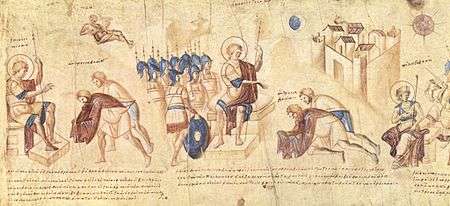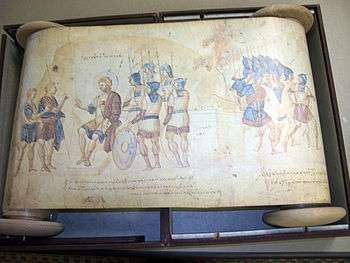Joshua Roll
The Joshua Roll is a Byzantine illuminated manuscript of highly unusual format, probably of the 10th century Macedonian Renaissance,[1] believed to have been created by artists of the Imperial workshops in Constantinople,[2] and now in the Vatican Library.[3]


Form and content
The Roll is in the form of a continuous horizontal scroll or rotulus, common in Chinese art, but all but unique in surviving examples of medieval Christian art.[4] It is made of several joined pieces of sheep vellum, is 31 cm high and about 10 metres long, and may be incomplete, as it starts with Chapter II and ends with Chapter X.[5][6] The Roll covers the early part of the Old Testament Book of Joshua using a reduced version of the Septuagint text; it includes Joshua's main military successes, ending with conquered kings paying him homage. At roughly this time, the Byzantine empire was enjoying military success in its campaigns in the Holy Land. It was originally painted in grisaille, by several artists, with partial coloring added later in a separate stage. The lettering is in majuscule and minuscule forms.[5]
Style
Like the Paris Psalter, with which it is usually discussed, it is heavily classicising in style, though the extent to which this represents a revival or copying from a much earlier model is the subject of much debate. Its origins have been much debated by art historians, and the roll is considered to be "one of the most important and difficult problems of Byzantine art."[7] The roll itself is usually acknowledged to be of the 10th century AD, but the images are felt by most art historians to derive from one or more earlier works, perhaps going back as far as Late Antiquity. The subject produced a sharp disagreement between Kurt Weitzmann, who thought the form of the roll was a classicising invention of the Macedonian Renaissance, and Meyer Schapiro, who, whilst agreeing with Weitzmann on a 10th-century date, held to the more traditional view that painted rotuli existed in Late Antiquity, and that the roll was essentially copied from such a work, perhaps through intermediaries.[7][8]
The images are clearly closely related to later manuscripts of the Octateuch or first eight books of the Old Testament,[9] but where and when the compositions for the cycle originated is controversial.[10]
Steven Wander, professor at the University of Connecticut, claims the images are slanted at ten degrees, in a continuous frieze along the ten meters of the roll. He suggests this may be because the roll was a copy of the actual preparatory sketches or working drawings for a real column, possibly to scale, like the bronze Easter column (Latin 'colonna') for Bishop Bernward in Hildesheim.[11]
See also
- Macedonian Renaissance
- Castelseprio – Frescoes in a related style
- Utrecht Psalter
- Leo Bible
Notes
- "The 10th-century Joshua Roll is interesting as an example of Byzantine illuminated manuscript that shows the tenacious influence of Greco-Roman painting." Excerpted from "painting, Western." Encyclopædia Britannica. 12 January 2007.
- "These illustrated book rolls could well have been derived from classical triumph columns whose artistic contents were rediscovered at the time when our manuscript was made. The Joshua Roll is generally thought to go back to Greco-Roman forms and painting."
- as "Palat. Gr. 431", in the Biblioteca Apostolica Vaticana
- Most rotuli, illuminated or not, are vertical in format.
- Facsimiles of Illuminated Manuscripts of the Medieval Period
- Schapiro, however, wonders if the manuscript, which covers Joshua's main military campaigns, was ever intended to be longer than it is. Chapters II–X according to Schapiro, I–XII according to Carleton College below.
- "The Joshua Roll: A Work of the Macedonian Renaissance" – (a review of the named book by Kurt Weitzmann.) Review written by Adolf Katzenellenbogen. Published in Speculum, Vol. 26, No. 2. (Apr. 1951), pp. 421–425.
- The Place of the Joshua Roll in Byzantine History (1949) and The Frescoes of Castelseprio (1952 & 1957) in Meyer Schapiro, Selected Papers, volume 3, Late Antique, Early Christian and Mediaeval Art, 1980, Chatto & Windus, London, ISBN 0-7011-2514-4 (or all on JSTOR).
- "Now believed to have been assembled in the tenth century on the basis of earlier, individual miniatures adorning volumes of the Octateuch (first eight books of the Bible: Genesis – Deuteronomy and Ruth, Joshua, and Judges), the Joshua Roll presents the illustrated text of the first twelve chapters of the biblical book of Joshua, when Joshua is most active and successful in his conquests.".
- See Schapiro, Castelseprio op cit.
- in the Stamford Times Professor re-examines mysterious document Archived 14 January 2007 at the Wayback Machine
References
- Walther, Ingo F. and Norbert Wolf. Codices Illustres: The world's most famous illuminated manuscripts, 400 to 1600. Köln, TASCHEN, 2005
Further reading
- Wander, Steven H., The Joshua Roll. Wiesbaden: Reichert Verlag, 2012, ISBN 9783895008542
External links
- Full digital facsimile of the manuscript on the site of the Vatican Library
- " Professor re-examines mysterious document"
- The glory of Byzantium: Art and Culture of the Middle Byzantine Era, A.D. 843–1261, an exhibition catalog from The Metropolitan Museum of Art (fully available online as PDF), which contains material on the Joshua Roll (cat no 162)